Ford Fairlane Lola GT
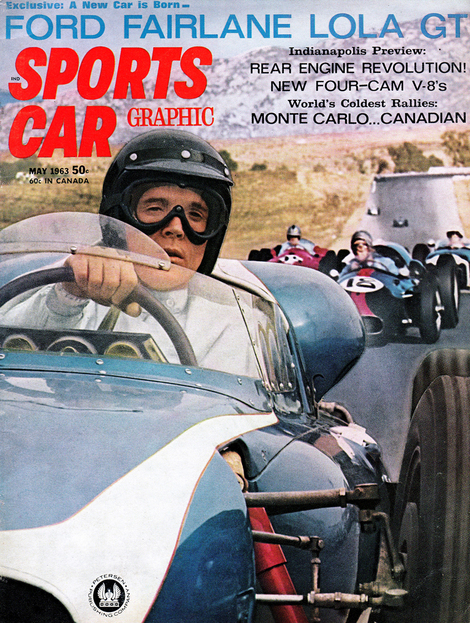
Could the Ford Fairlane Lola GT (later known as the Lola Mk6 GT) be the inspiration and forerunner of the Ford GT 40? Styling and design clues are certainly similar. In researching this car I found few historic records although the cast of characters were the same.
By the early 1960s the Ford Motor Company decided to adopt a more youthful image. They felt one of the best ways to do so was to go out and win races in general and the 24 Hours of Le Mans in particular. Due to the gentleman's agreement between the three big American companies to stay out of racing, Ford desperately lacked the experience or know-how to take on the specialized, European manufacturers. Fortunately, the third ingredient required, money, was available in abundance. In an attempt to get into racing quickly and easily, Ford tried to buy the entire Ferrari operation. When the negotiations turned sour, Henry Ford II and his men did not give up, but instead decided to learn the Europeans a lesson with a completely new Ford racer.
Ford already gave backdoor support to Caroll Shelby for his Cobra racing cars, but in the end having to the share the credits with Shelby and AC Cars was not to the company's liking. In 1963 the decision was made to build a prototype sports racer that, unlike the Cobra, was built to score overall victories. They were realistic enough to realise that outside help was needed and after closely looking at companies like Lotus and Cooper, Ford eventually teamed up with Lola. This Eric Broadley run company had just completed a Ford-powered, mid-engined sports racer that would form the ideal basis for the new project. A new company called Ford Advanced Vehicles (FAV) was founded, which would be responsible for the engineering and construction of the cars. Broadley was responsible for the overall design, fellow Englishman Len Bailey took care of the chassis design and John Wyer was hired as team manager.
Bailey's chassis design closely followed that of the Lola Mk6 GT with the initially used aluminum replaced by steel for additional durability. Broadley was not very happy with the added weight, but Ford felt it was necessary to cope with the heavy and powerful engines proposed for the new car. The all aluminum, dry-sump Ford Fairlane engine was also carried over from the Lola. In good American tradition, this V8 featured a central camshaft with push-rod operated overhead valves. It was intended to be used as a stop-gap until a four-cam version would become available. In later years one of these Indy-racing derived engines was indeed fitted, but the racing and production cars all featured OHV engines. The Fairlane engine displaced just under 4.2 litres and produced a decent 350 bhp. It was mated to a Colotti four speed gearbox. For the design of the all-round independent suspension highly advanced computers were used. The neatly packaged car was tightly clothed in a fibreglass body. For easy access, the doors were well cut into the roof. At a car show in England, an Englishman named Eric Broadley displayed a Ford powered body he called the Lola GT. The body was very aerodynamic, the roof was only 42" off the ground. The construction was very unique for a race car, it was a uni-body. The car did not have a frame as other cars did. Instead, the body was one piece forming the frame of the car. The term uni-body was used to describe the car.
And so it would seem began the refinements which went on to become the Ford GT 40 as we know it and it's subsequent variations.
Ford Fairlane Lola GT: Here's the full story on the most sensational Grand Touring car of 1963!
by John Blunsden Photos: John Blunsden & Geoffrey Goddard
recreated from Sports Car Graphic May 1963
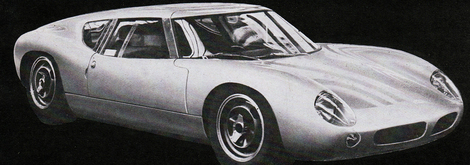
THE DRAMATIC LATE ENTRANCE may be a time-honored gimmick of Hollywood publicity agents to focus attention on a new starlet, but the fact that the Lola GT prototype became one of the stars of London's Racing Car Show (see last months SCG) had nothing to do with its arrival at Olympia about two days after the rest of the exhibits - it was a victim of a power failure at Eric Broadley's Bromley, Kent, workshops.
As it took its place on the combined Lola and Bowmaker stand it was mobile, but not drivable (the drive shafts were missing, for a start). Afterwards it went straight back to Bromley, where it was stripped, refined, and as this report is being written, is being methodically reassembled. The intention is to make this first car the works' development machine, but until it can be taken to a circuit one can only guess at its performance - which is potentially outstanding.
Eric Broadley will be an extremely lucky man if he finds that such a bold new design is 'right' from the very start, and that he doesn't have to make any detail design improvements. Broadley is well aware of this, and is prepared for a lot of hard development work during the coming months. But he does not anticipate that any basic re-designing will be necessary; rather does he expect to be plying around with suspension details, body refinements, and possibly metal thickness - exact dimensions and gauges, therefore, will not be included in this technical description.
There is an interesting train of thought behind the design of the Lola GT. It may be recalled that Eric Broadley's reputation as a racing car designer was based, more than anything else, on his remarkably successful front-engined sports cars. It is natural, therefore, that he should have retained a close interest in two-seaters, even though his other activities until recently prevented him from building a successor.
It was early in 1962 that Broadley decided that it was time he climbed back on the sports car band wagon - at just the time when Colin Chapman had introduced his Lotus 23 and Frank Nichola his Elva Mark 6. Another small-capacity Lola sports car seemed to be the answer, but Broadley soon became disappointed that this class failed to attract the attention of really top-drivers in Europe, and instead, somewhat like Formula Junior, was being used as a stepping stone to the top.
Having long held an affection for "big banger' engines, be therefore switched his interest to a large capacity sports car. And it was while sketching out his first 'doodles' that he thought he might just as well go the whole hog and build a GT version as well. This would, if nothing else, help him to catch up on the Lotus and Cooper, both of whom were expected to produce GT versions of their established sports car designs.
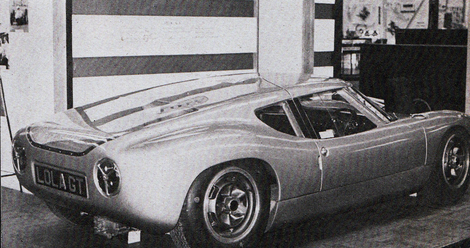
At a time when the relative merits of space-frame and monocoque construction are being put in single-seater cars, the Lola steers a mid-way course by embodying both types of structure. It has been described as a semi-monocoque, but more accurately it consists of a pair of steel pontoons, joined by a stressed aluminum floor to form a center section, to which a tubular space-frame structure is attached at the front, and a steel-reinforced glass-fiber roof section built on top. The pontoons converge behind the cockpit, and with a bridge structure they form anchorages for the engine and transmission. Simple frame extensions, front and rear, then provide the mounting points for the pivoting glass-fiber body moldings (made like the Formula Junior Lola bodies, by Specialized Moldings).
The pontoons in the cross-section are like a quarter of a circle, and are sectioned off into compartments by a series of 'L' shaped bracing members, each of which carry two large-diameter holes, through which run the oil and water delivery lines. The side members also house flexible fuel tanks, which are to be interconnected, and fed from a single filler just forward of the front screen on the right side.
 You have to image that this centerfold was drawn by hand as there was no CADD or sophisticated drawing programs in 1963.
You have to image that this centerfold was drawn by hand as there was no CADD or sophisticated drawing programs in 1963.
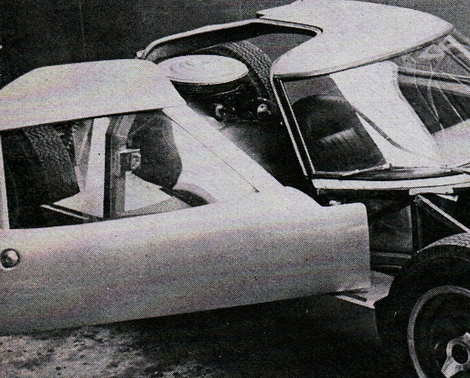
Substantial uprights on the front end of the pontoons mark the beginning of the space-frame structure, which provides a base for the windshield frame. Dual heavyweight hinges are also provided at this point for the ingenious doors, which couple a conventional opening arrangement with some of the advantages of a gull-wing design. Broadley reveals that had not the CSI regulations at the time he designed the car expressly precluded gull-wing doors, he would probably have settled for this arrangement, but his compromise certainly seems to work very successfully. In view of the usually low height of the body (the roof stands 52 inches high, and five inches of that are ground clearance) some form of roof opening was inevitable unless the driving was to be restricted to midgets!
The 'L' shaped glass-fiber doors have Plexiglass sideways-sliding window panels and blend in extremely well with the main structure. This is formed from a double glass-fiber skin enclosing a tubular steel frame, which provides the necessary roll-over stiffness, the tubes running around the front screen, along the 'spline' of the roof, then down the body sides immediately behind the door openings.
Although the body has not been wind tunnel tested (Broadley believes that these tests can be misleading) there seems little doubt that the Lola has an efficient as well as attractive shape. The man responsible is John Frayling, an industrial designer who styled the Lotus Elite. One of the problems in designing a car of this type is to minimize the wind disturbance around the top of the windshield, and this has been achieved by rolling the roof section forwards on to the top of it. For this reason, the windshield curves in one plane only, allowing a neat bond to be concealed beneath the glass-fiber along the top edge.
A feature of the body is the clean line from the top of the windshield to the rear of the car, broken only by a small, roughly triangular shaped opening just behind the doors where they meet close to the centerline of the car. This is the air intake to the carburetors, the opening allowing air to be channelled through a 'funnel' between the roof and floor behind the cockpit. Let's hope that development tests prove that the modest roof opening is sufficient for this purpose, because it would be tragic to have to spoil this delightful shape with extra exposed ducting.
The Lola has been designed to take a variety of large-capacity engines, but the prototype has been fitted with one of the Ford Fairlane 4,262 cc V8, breathed on by Carroll Shelby to produce 260 horsepower at 5,800 rpm, on a compression ratio of 9.2 to 1. Maximum torque is given as 269 pounds feet at 4,500 rpm. The potentialof this power unit, of course, is considerably greater, and something between 300 and 350 horsepower is likely to be used on the racing versions.
The new four-speed transmission by Gear Speed Developments (Colotti-Francis) is used, this unit being designed to bolt straight on the Ford engine, and to transmit up to 400 horsepower. This is the transmission which, in slightly different form, is being used on the Lotus 29 Indianapolis cars, with their much-modified Ford engines. As used in the Lola in the Lola the normal final drive ratio will be 3.27 to 1, which provides overall ratios of 8.18, 5.58, 4.235 and 3.681 or 3.488 to 1. An alternative final drive ratio of 3.09 to 1 is also available, and this results in overall figures of 7.727, 5.27, 3.949 and 3.477 to 3.295 to 1. A quick-change arrangement allows third and fourth gears to be changed with the unit still in the car. To cope with the considerable horse-power, Borg and Beck are supplying twin-plate versions of their eight-inch diaphragm-type clutch. Rubber couplings are used on the ends of the tubular drive shafts.
Apart from the possibility of using alternative American engines, the Lola GT is also likely to be seen around with either the 2.5 liter or the 2.7 liter FPF Climax power unit.
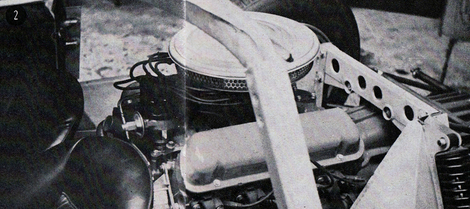

From a suspension standpoint the Lola is fairly conventional, with coil springs and wishbones all round. At the back end the top wishbones are formed from single transverse arms, and radius arms linking the suspension uprights with the body structure just behind the door openings, the coil-spring-damper units moving within the 'V' formed by two links. The 'sandwich'-type chassis bridge structure forms the inner anchorage for the leading arms of the cross-braced lower wishbones, as well as for the single top arms, and also is the pivot point for additional transverse lower arms coupled to the leading edge of the suspension uprights. The trailing arms of the lower wishbones link up with the small extension frame at the extreme rear chassis. The double-wishbone front suspension offers no surprises, being typical of an arrangement with a space-frame chassis. Following current practice, the suspension outer pivots are ball-jointed. Anti-sway bars are being provided, front and rear.
Steering is by rack and pinion, giving 2 1/2 turns from lock to lock. The Lola would appear to be very adequately braked, Girling 11-inch diameter discs being fitted outboard all round. A very businesslike type of magnesium road wheel is used, having a center-lock fixing on the GT model, and a sx-stud fixing on the sports car. Tire sized are 5.00 x 15 inch at the front, and either 6.50 or 7.00 x 15 inch at the back. It was very apparent at Olympia that even making allowances for the larger-than-standard front tires fitted to the prototype, the body cutaway was insufficient for the car to be steered; a considerably larger cutaway will be provided on production cars.
The front-end layout is very neat, the large combined radiator being mounted on an extension tray with bracing arms, and the spare wheel nestling in most neatly between the tubular frame and body moulding.

I tried the car for size at Olympia, and found it a most interesting experience. Entry is not too difficult once you accept the long reach over the side sills. You just step on the seat, then on the floor ahead of the steering wheel, then gradually lower yourself down as the feet start to hunt for the pedals. The seats provided on this particular car would be too deeply padded to give the necessary headroom with a helmut on, and the very relaxed driving position (real Lotus 25!) would definitely be more comfortable with the seat cushion an inch lower. In view of the well-back seating position, the toggle switches on the dashboard will call for a lean forward, but the gear shift is very well placed. Forward visibility seems to be satisfactory, and cornering should not pose any unusual sighting problems, but a pair of really efficient external mirrors will be needed to see what's happening behind! The air intake funnel, of course, obstructs some of the view through the rear screen, and the sharp rake of the Plexiglass will make it more than usually prone to reflections. Still, if the performance of this newcomer is up to expectations, there'll be little enough need to keep a look-out behind!
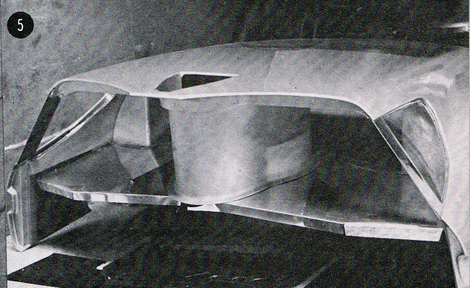
While the GT prototype is being prepared for its first tests, the first of the sports models is under construction, and is likely to go to Hugh Dibley, who has already owned a series of Lola Formula Junior machines. The aim (which may prove to be a bit optimistic, due to the hold-up in circuit testing in Britain during recent months) is to get this car ready for the Easter Monday race meeting at Goodwood.
After that there is quite a comprehensive competition program in mind. The intention is to run at least one works car in the important International events (Sebring is too early, but the car should be seen in the Nurburgring 1,000 kilometers, Le Mans, the Reims Six Hours, and possibly Targa Florio). Two Le Mans entries have been applied for, second to be taken up, Broadley hopes, by a private team. Looking even further ahead, the long-range plans are to get the car homologated as a ©† model, and with this in mind a 'road going' specification is planned, which should also bring the price down well below the 'something over 5,000 pounds' ($14,000) which it seems, will be the size of the ticket for a racing GT in Britain.
For the record, the prototype measures 154 inches long, 63 inches wide, 52 inches high, and has an 82-inch wheel-base. Weight is estimated as 1,550 pounds. In short - it's quite a motor car!!!
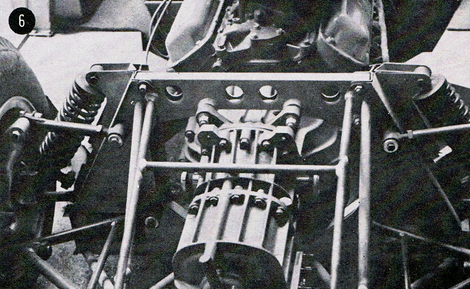
Motorsport was going through a big revolution in the early 1960s; from front to mid engined racers. Not surprisingly endurance racing was the last category to fully pick up on the latest developments. For size reasons, the mid mounted engine much favoured smaller engines. Never quick to react to changes, Ferrari continued to run front engined prototype racers up until 1962, which were able to fight off the mid-engined competition with their well developed chassis and hugely powerful engines. The 1963 season proved to be a most important year and a turning point in Le Mans history; Ferrari entered a mid-engined V12 prototype and maybe even more important was the small Lola Mk VI GT roaring down the long straights. The first car was completed in time to make a late debut at the 1963 Racing Car Show in the UK. This was the steel monocoque, which was never fitted with an engine, but it was enough to stun the crowds. The first aluminum car made its debut at the Silverstone Daily Express Meeting in May, where it was driven by Tony Maggs. Starting from the back, Maggs had never driven the car before, but still managed to finish an incredible fifth. Next up was the Nurburgring 1000 km race, where wheel nut problems put the car out of the race. Meanwhile Lola worked hard on completing a second car to race at Le Mans. Eventually one car was ready and eligible for the 24 Hours race. All the scruteneering problems gave Lola no time for real testing, which was most obvious on the long straights; the wrong gearing was chosen. Drivers David Hobbs and Richard Attwood had to back off the throttle at speeds which later proved to be at least 30 mph under the car's potential topspeed. Despite the gearing problems the Lola clocked very competitive lap times and was running as high as fifth in the race. Sadly the gearing was not the only problem of the Colotti gearbox; it also started to suffer from a selection problem in the race. In the 15th hour of the race Hobbs crashed out as a result of the gearbox problem. It was to be the last outing for the Ford powered Lola Mk VI GT. Featured is the Le Mans racer, pictured here at the 2004 Le Mans Classic. After its use as a test machine, it was stored partly built for many years. It was eventually restored in 2000 and 2001 to its original Le Mans specification.
General specifications**
Country of origin Great Britain
Chassis number 003
Numbers built 3
Produced in 1963
Body design John Frayling
**Engine Configuration** Ford 90º V 8
Location Front, longitudinally mounted
Construction cast-iron block and head
Displacement 4.727 liter / 288.5 cu in
Bore / Stroke 101.8 mm (4 in) / 72.9 mm (2.9 in)
Compression 12.0:1
Valvetrain 2 valves / cylinder, OHV
Fuel feed 4 Weber Carburetors
Aspiration Naturally Aspirated
Drivetrain**
Chassis/body fiberglass body on semi-monocoque
Suspension (fr/r) double wishbones, coil springs over dampers, anti-roll bar
Steering rack-and-pinion
Brakes discs, all-round
Gearbox Colotti 4 speed Manual
Drive Rear wheel drive
Dimensions**
Weight 950 kilo / 2094.4 lbs
Length / Width / Height 3912 mm (154 in) / N/A / N/A
Wheelbase / Track (fr/r) 2356 mm (92.8 in) / 1308 mm (51.5 in) / 1308 mm (51.5 in)
Performance figures**
Power 400 bhp / 298 KW
Torque 462 Nm / 341 ft lbs
BHP/Liter 85 bhp / liter
Power to weight 0.42 bhp / kg
Top Speed 290 km/h / 180 mph
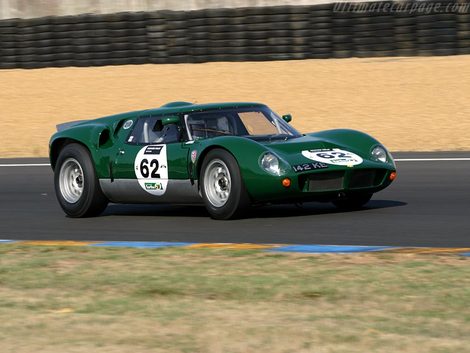
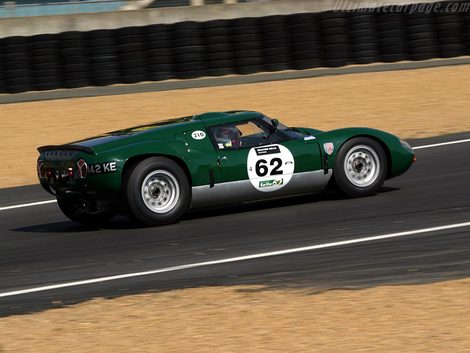
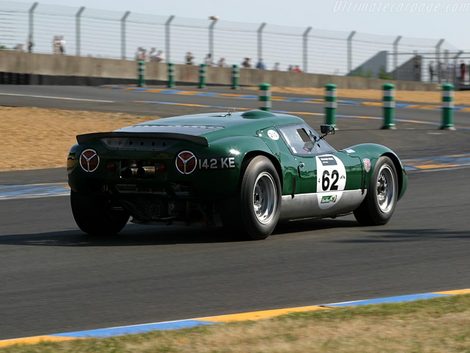
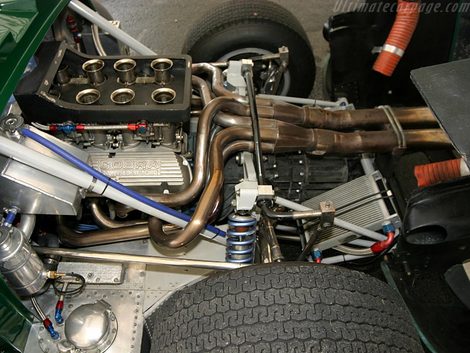
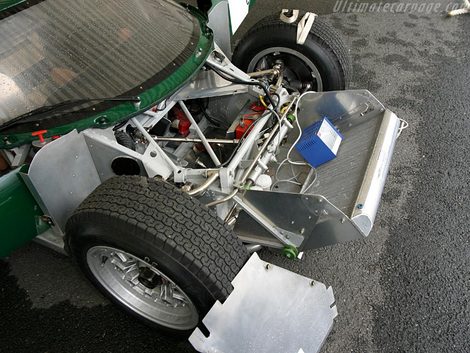
Posted 10/05/08 @ 02:52 PM | Tags: Ford Fairlane Lola GT, 1963 Ford Fairlane Lola GT, Sports Car Graphic May 1963, forerunner Ford GT 40?, Lola Mk6 GT, Lola Mk Vl GT, monocoque chassis, semi-monocoque chassis, Ford Advanced Vehicles Ltd, Frank Nichola, Carrol Shelby, Gear Speed Developments, Girling brakes, Eric Broadley, Sports Car Graphic magazine